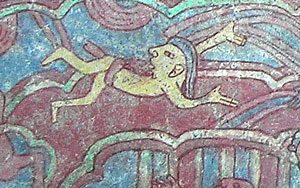

Although the two goddesses often overlapped, they were distinct from one another. She was believed to be the personification of youth, beauty, and zeal, although she should not be confused with Tlazolteotl (also known as Ixucuina or Tlaelquani), who was the Aztec goddess of midwives, steam baths, purification, sin, and was the patroness of adulterers. Ĭhalchiuhtlicue was often depicted as "a river, out of which grew a prickly pear cactus laden with fruit, which symbolized the human heart." (Schwartz 2018, 14). In addition to water-related deaths, Chalchiuhtlicue presided over birth rituals, bathing of sacrificial victims and ceremonial actors, judiciary purification, royal investiture, and the recycling of ritual waste. Ĭhalchiutlicue was associated with the many fasciates of water as well as being credited with being involved with the death of those who died in drowning accidents. It is important to note that the Aztecs first began to use maize under her reign, which became a paramount staple to the Aztec diet and economy. The Fifth Sun is the world which we now occupy. Following the flood, the Fifth Sun developed. She built a bridge linking heaven and earth and those who were in Chalchiuhtlicue's good graces were allowed to traverse it, while others were turned into fish.

It is believed that Chalchiuhtlicue retaliated against Tlaloc's mistreatment of her by releasing 52 years of rain, causing a giant flood which caused the Fourth Sun to be destroyed. In the Aztec creation myth of the Five Suns, Chalchiuhtlicue presided over the Fourth Sun or the fourth creation of the world. She often withheld a dual role in Aztec mythology as both a life-giver and life-ender. It is thought that her association with water and fertility speaks to the Aztecs' association with the womb and water. She is often associated with serpents, as most Aztec water deities are. Īccording to myths, Chalchiuhtlicue once ate the sun and the moon. Chalchiutlicue brings fertility to crops and is thought to protect women and children. In Aztec religion, Chalchiuitlicue helps Tlaloc to rule the paradisial kingdom of Tlalocan. In other texts, she was the wife of Xiuhtecuhtli, who was a senior deity for the Aztecs. She was also the mother of the Aztec moon god Tecciztecatl. Tlaloc and Chalchiuitlicue share similar attributes as they are both water deities however, Chalchiuitlicue was often associated with groundwater, unlike Tlaloc. Ĭhalchiuitlicue was the wife or sister of the Aztec god of rain Tlaloc, depending on the text. Religious significance Ĭhalchiuitlicue directly translates to "Jade her skirt" however, her name is most commonly interpreted as "she of the jade skirt." She was also known as Chalchiuhtlatonac (chalchihu-tla-tona-c) "She who shines like jade" and Matlalcueye "Possessor of the Blue Skirt" by the Tlaxcalans, an indigenous group who inhabited the republic of Tlaxcala. Chalchiuhtlicue belongs to a larger group of Aztec rain gods, and she is closely related to another Aztec water god called Chalchiuhtlatonal. Chalchiuhtlicue was highly revered in Aztec culture at the time of the Spanish conquest, and she was an important deity figure in the Postclassic Aztec realm of central Mexico. Chalchiuhtlicue is associated with fertility, and she is the patroness of childbirth. Minneapolis Institute of Arts, 2009.33Ĭhalchiuhtlicue (from chālchihuitl "jade" and cuēitl "skirt") (also spelled Chalciuhtlicue, Chalchiuhcueye, or Chalcihuitlicue) ("She of the Jade Skirt") is an Aztec deity of water, rivers, seas, streams, storms, and baptism. Chalchiuhtlicue, unknown Aztec artist, 1200–1521, gray basalt, red ochre.


 0 kommentar(er)
0 kommentar(er)
